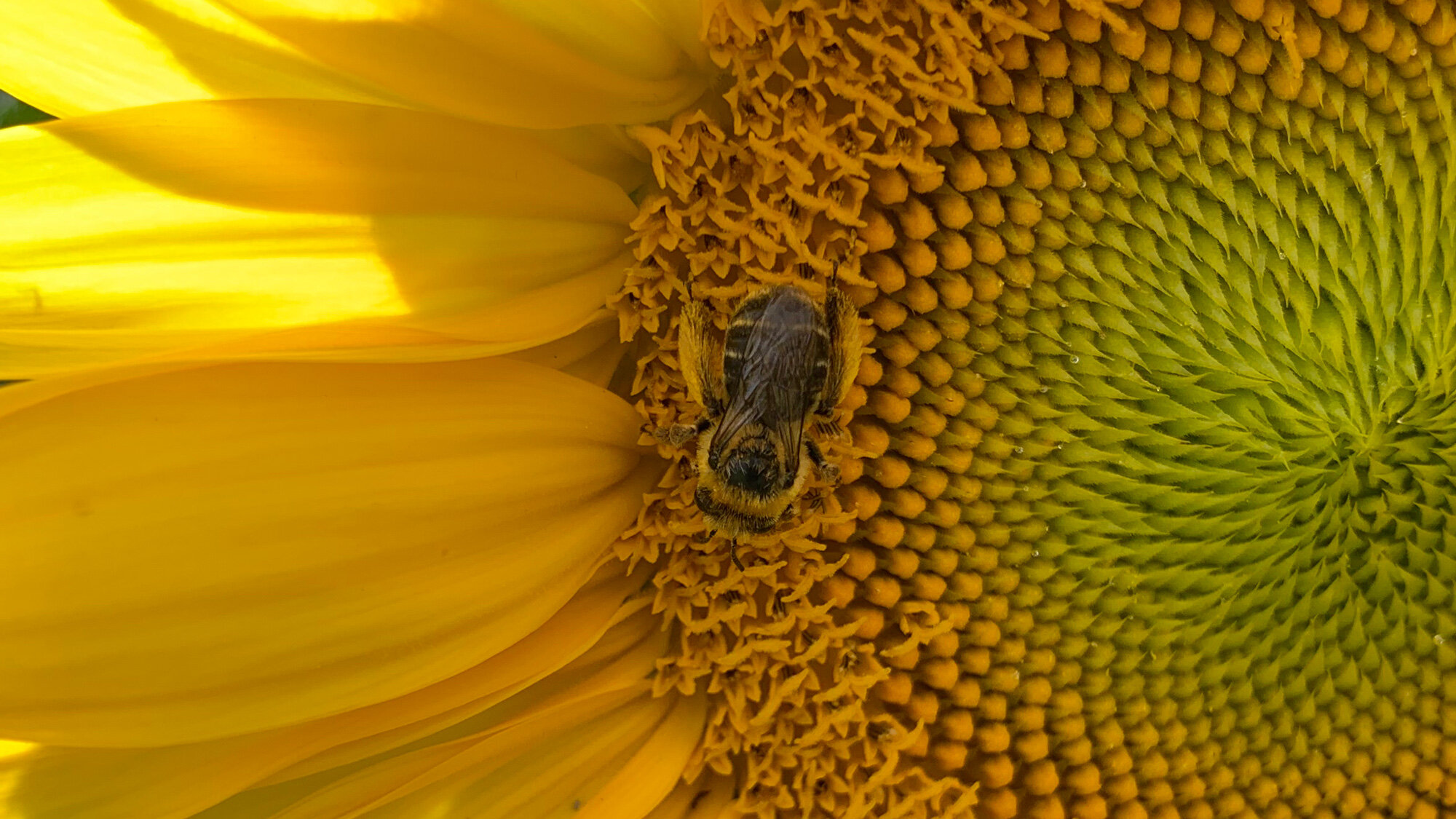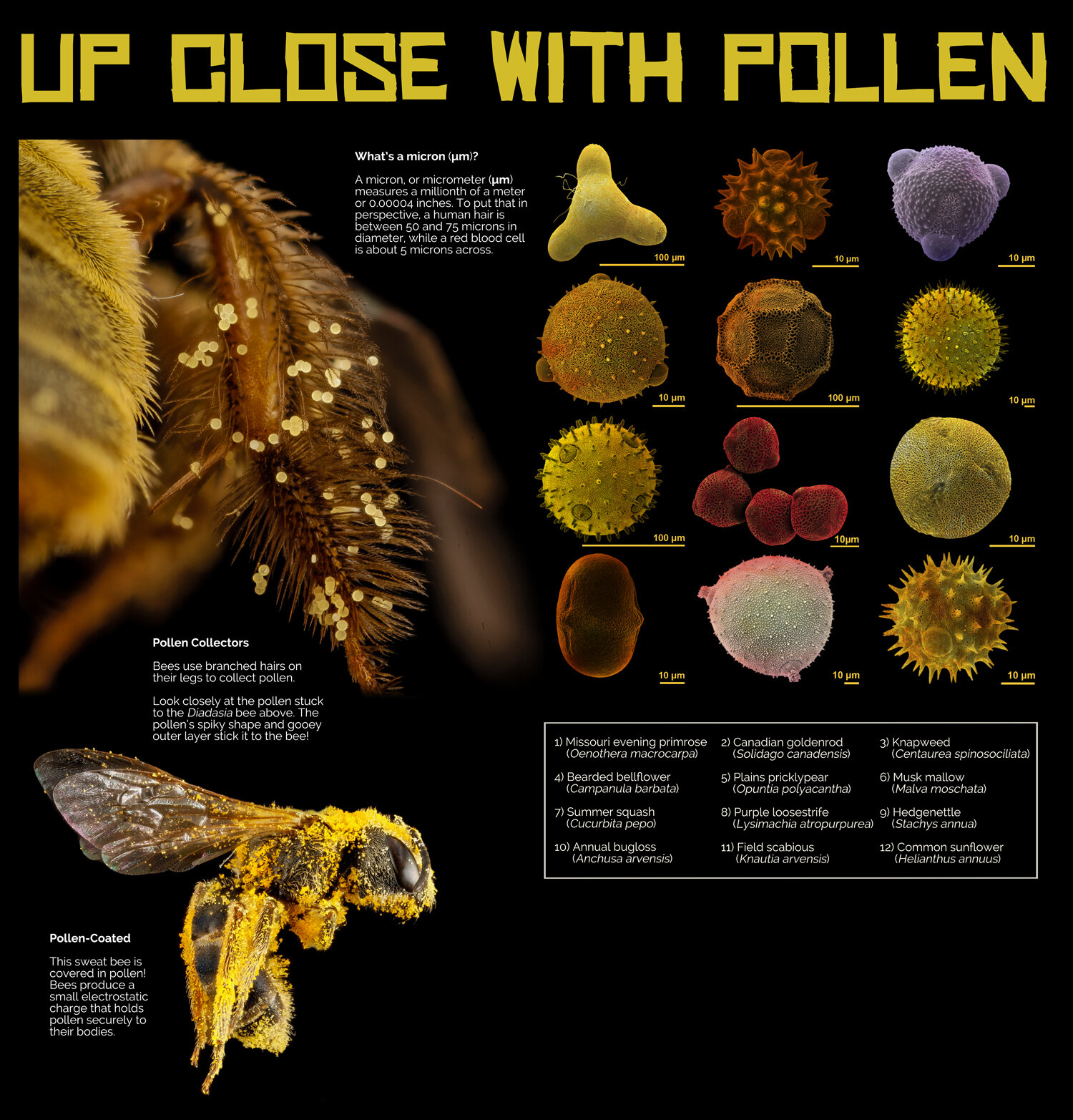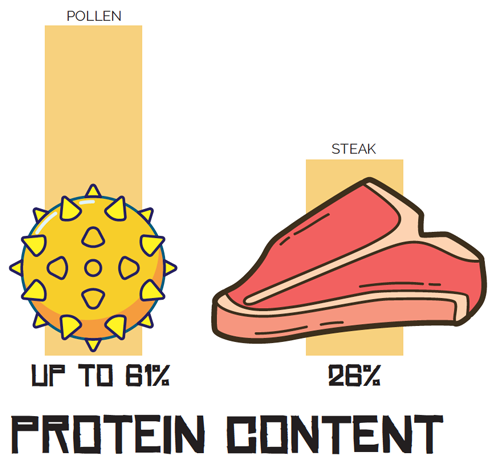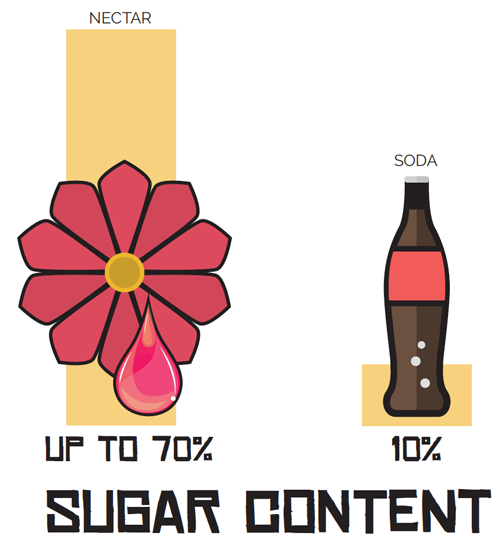What do bees eat?
Flowers and pollinators depend on each other for survival. Flowering plants (angiosperms) are the most diverse group of living plants. Most flowering plants rely on insects such as bees for pollination (learn more about pollination here). Insects are efficient pollinators because they can move directly from one flower to another, picking up and unintentionally depositing pollen along the way, allowing angiosperms to reproduce.
Thus, insect-pollinated flowers have evolved an array of colors, patterns, fragrances, shapes, and “floral rewards”—including pollen, floral oils, and nectar (see below)—to attract their pollinators. These three floral rewards have different nutrient and energy content, and a different amount of energy is required from the plant to produce each one.
A bee on a sunflower, a type of angiosperm.
“Slo-Mo Footage of a Bumble Bee Dislodging Pollen” by Smithsonian Channel (YouTube).
Pollen
Pollen is a powdery substance that contains plant sperm. Pollen from different flowers takes different shapes. This variety prevents cross breeding with other plants. Durable internal layers give pollen grains their texture and shape. Pollen’s resilience makes it hard for most animals to digest, but it’s perfect for fossilization.
Up-close views of pollen grains, including grains stuck to bees. Graphic by Andrielle Swaby using images by Sam Droege (USGS Patuxent Wildlife Research Center; public domain).
Pollen is the primary source of protein for bees. The protein content of pollen varies between 2.5% and 61%, depending on the plant species. For context, beef is approximately 26% protein!
The outermost coating on a pollen grain is soft and gooey. It sticks to the bodies of bees and other pollinators. The inner layers of the pollen grain are rigid and indigestible, protecting the nutrient-rich cytoplasm at the center. It’s difficult for most animals to digest pollen, but bees have digestive enzymes that soften the pollen grain’s rigid layers.
Bees evolved physical structures for harvesting pollen, including specialized brushes, combs, and rakes on their legs, abdomen, or mouthparts. Bees that prefer certain plants may have specially-shaped hairs on their bodies to pick up their favorite pollen. All non-parasitic bees developed mechanisms for carrying pollen from flowers back to their nests. Most bees transport pollen externally, but some bees consume the pollen and carry it in their crop or “honey stomach.” Bees also produce a small electrostatic charge, which helps the pollen stick more securely to their bodies.
Blue-banded bee using a technique called “banging” to dislodge pollen from a flower (YouTube).
Floral Oils
Floral oils are the most energy-rich floral reward. Oils are produced by 1,500 to 1,800 species of flowering plants. Multiple angiosperm families have evolved to produce floral oils since the Cretaceous Period ended 66 million years ago. Each family evolved this trait independently and at different points in their evolutionary history. Today, 11 flowering plant families produce floral oil.
Virtually no oil-producing flowers produce nectar, so oil is their primary reward for pollinators. Floral oils are produced in glands called elaiophores, which oil bees break open with special hairs. Bees carry oil back to the nest on their legs or abdomen.
Oil-collecting bees occupy a variety of habitats across the globe, but are most common in the tropics. These 440 species of bees use floral oils to nourish and protect their offspring. They line the walls of their brood cells with the antimicrobial oil and feed their larvae with this energy-rich substance in place of nectar.
Oil-containing flowers and their bee pollinators (YouTube).
Nectar
Nectar is made of water, sugar, carbohydrates, amino acids, and proteins. Flowers produce nectar from special structures called nectaries. Different plants produce different types of nectar to attract particular pollinators. Nectar may be scented or contain certain stimulants like caffeine to entice pollinators and help them remember the plant.
Nectar sugar concentration can vary from 7% to 70% by weight, but most nectar is between 25% and 55% sugar. By comparison, Coca-Cola is about 10% sugar by weight!
Bees use their complex mouthparts to access nectar. The 17 interlocking, moveable parts allow bees to lap up and even suck nectar from flowers. Bee mouthparts vary in shape and length depending on the shape of the flowers they prefer.
Other Bee Food
Tears
Bees collecting protein from human tears.
A small number of social, stingless bees in Thailand collect tears instead of pollen. The tears of large mammals like dogs, humans, and cattle contain protein that the bees seek out and collect. These species have an expandable abdomen used for storing and carrying liquids. The bees don’t transmit diseases or have a negative impact on hosts who supply the tears, though it does tickle a bit when they’re harvesting!
Meat
Meat-eating bees.
Vulture bees in Central and South America have developed a surprising change in their diet. Instead of getting protein from pollen, vulture bees feed on carrion. The bees collect rotting meat, chewing it before they return home. In the nest, adult bees store and consume the meat, converting it to a protein-rich secretion used to feed their larvae. These bees have a reduced physical capacity to carry pollen, having switched to an animal protein diet.
Fungi
Bees that feed on fungi.
Scaptotrigona depilis, a social stingless bee from Brazil, has taken a unique approach to feeding its larvae. This species not only exclusively feeds on fungi, but actively cultivates it within the nest as larval food. The bees raise the fungi, feeding it with a blend of pollen and nectar as it grows. They even transplant their crop from one nest to another, carrying it within a wax-and-resin mixture used to build nest walls. This is the only known bee species that cultivates its own food!
Evolutionary Arms Race
The evolutionary connection between flowering plants and their insect pollinators helps to explain the great diversity of angiosperms alive today. Bees and flowering plants have a complex give-and-take relationship. We often think of bees as pollinators, but bees are really herbivores gathering food for their offspring. A bee’s role in pollination is completely incidental. They’re just trying to collect the most pollen, nectar, or floral oils possible. To plants, bees are useful tools in their quest to spread pollen and reproduce. Plants have evolved devious ways to manipulate their pollinators, and bees have developed counter-strategies to maximize their harvesting capacity.
Tricky Plants
Plants work hard to limit the loss of pollen, nectar, or oils while maximizing the chance of pollination. Some plants trick bees into returning multiple times by dispensing pollen in small doses or releasing floral rewards slowly over time. Other flowers place barriers in the way of pollen or nectar harvesting so that only certain bees can access their floral rewards.
Some plants, like bee orchids, take an especially deceptive approach. Bee orchids look and even smell like female bees! When male bees are lured in and try to mate with the decoy female, the orchid deposits a sticky packet of pollen onto the bee. As the bee travels to similar orchids, he spreads the pollen. The orchid is essentially tricking the bee into being an effective pollinator, and the bee gets nothing useful in return!
“The bee orchid, Ophrys apifera” by Natural History Museum (YouTube).
Other species take a more lethal route to control their pollinators. The death camas (Zigadenus) produces a neurotoxin in its leaves, pollen, and nectar. It is poisonous enough to kill humans and livestock, not to mention bees! Despite this, one bee species (Andrena astragali) loves death camas pollen and is probably the plant’s only pollinator. The death camas can’t self-pollinate and the bee lives exclusively off of its pollen – they are locked in a relationship of mutual survival.
Bandit Bees
A blue-banded bee robbing nectar by piercing the petals. © Erica Siegel AAPS AFIAP Wildlife Photography.
Some bees, including honey bees and carpenter bees, rob flowers of their nectar and bypass pollination completely. Instead of picking up pollen from the anthers of the flower, these bees cut slits in the petals, sneak their heads in, and steal nectar directly.
Buzz Pollination
Over 22,000 plant species limit bees’ access to their pollen by enclosing it in a poricidal anther, a structure with just a small opening. Bees use a technique called buzz pollination (sonication) to access the pollen. When buzz pollinating, bees grab hold of the flower and vibrate their flight muscles. This action transfers the vibrations to the flower, forcing the pollen out and on to the bee.
“This Vibrating Bumblebee Unlocks a Flower’s Hidden Treasure | Deep Look” by PBS Deep Look (YouTube)
Comparison of buzzing behavior by 6 bee species (YouTube).
Tomatoes, peppers, strawberries, and other flowering fruits and vegetables all need pollinating for attaining large yields and fruit sizes. Tomatoes are one high-value, delicious fruit that requires buzz pollination.
All bees have the muscles needed to perform buzz pollination. Species from all seven bee families use the technique. However, only 58% of bee species use buzz pollination. Why some bees can buzz pollinate and others cannot is a mystery! Despite their reputation as great pollinators, honey bees are among the species that can’t sonicate, making them ineffective pollinators for certain plants. Bumblebees can, however, making them important pollinators of crop plants like tomatoes.
Perfumed Pollination
Orchids and male orchid bees in Central and South America have an unusual, sweet-smelling relationship. Unlike other male bees, orchid bees have a complex mating behavior involving the collection of fragrance from rotting fruit and plants, fungi, feces, and orchids. The fragrances are used to create perfume that attracts female orchid bees. These females choose their mate based on who creates the most attractive perfume.
Bucket orchids use their fragrant oils to lure the male bee, depositing pollen packets on his back before he leaves the flower. As a result of their mating behavior, male orchid bees are key pollinators for 600 to 700 different orchid species.
“An Orchid’s Trap | Wings of Life” by National Geographic Wild (YouTube).











